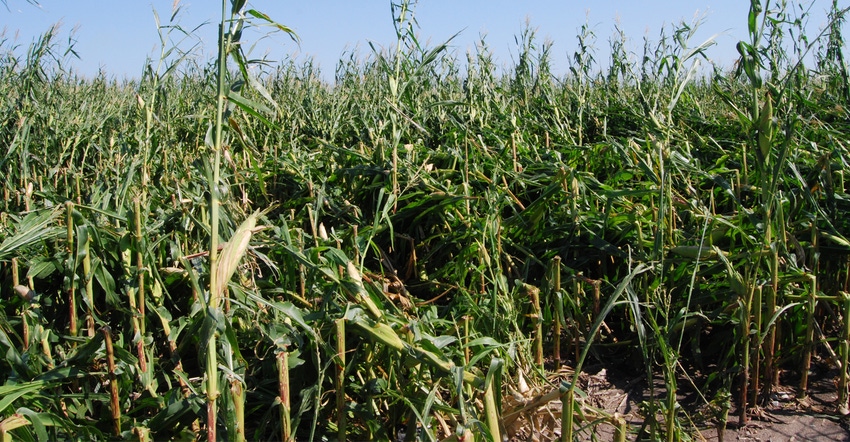August 26, 2020

Wind is a covered event in multiperil crop insurance, and farmers whose insured crop acres have been affected by the recent derecho windstorm may be eligible for indemnity payments.
Affected farmers should file a Notice of Loss with their crop insurance agent within 72 hours of the initial time of discovery of damage or loss, and then follow up in writing within 15 days. When filing a timely NOL is not feasible, a delayed NOL may be accepted.
The NOL allows the approved insurance provider (AIP) to contact the policyholder and decide on a case-by-case basis whether an indemnity will be paid. That decision will depend both on field conditions and a farmer’s decisions:
If the AIP determines that field conditions will prevent farmers from ever being able to mechanically harvest the crop, that production will be considered a full loss.
Otherwise, the farmer can choose to settle the case based on appraised production, or take the crop to harvest.
If a farmer chooses to harvest the crop (even if Option 1 first chosen), the farmer must accept the highest of harvested production or appraised production for claims purposes. Farmers who choose Option 1 first and then decide to harvest the crop must file a revised claim.
USDA’s Risk Management Agency, which writes the rules and oversees companies providing crop insurance, has the latest guidelines at rma.usda.gov.
Practical guidance for farmers
There are six key considerations to keep in mind when dealing with crop insurance and this wind-damaged crop:
1. Contact your crop insurance agent. Do this as soon as possible, and file a NOL.
2. Request RSAs. If you want an immediate release of the field for another use, you can request the use of representative sample areas by the AIP. These are areas of a field that the AIP authorizes to leave untouched for later appraisal when an accurate appraisal cannot be made at the present time. Appraisals from the RSAs of the unharvested crop acreage are later used to settle the claim.
3. Salvage remaining crop for silage. However, your indemnity payment might be affected depending on how the crop is insured. For corn insured for grain, once the AIP releases the field for another use, you can harvest for silage without penalty. For corn insured for silage, if you agree to settle in appraised production, but you still attempt to harvest for silage, you must accept the higher of the appraised or the harvested production for claim purposes.
4. Hay or graze a second crop. You can do this without penalty if the ground has been released for another use by the AIP, as it is not practical to replant the insured crop, and the second crop will not be insured. This might be of interest to farmers who use cover crops.
5. Destroy the crop. The only case in which you are required to physically destroy your crop production is when grain production is mature and no local buyers are willing to purchase it (typically due to molds and toxins in the mature grain), and it is not economical to ship it to other buyers. This is the case of a crop with zero market value, and destruction should take place whether the grain has been harvested or is still in the field.
6. Don’t harvest. A claims advisory from RMA on Aug. 21 indicated that the damaged crop in the released field for another use is not required to be harvested (even for appraisal of RSAs).
If you or someone you know need assistance with stress and disaster management, call or visit online the Iowa Concern Hotline. Trained staff will assist you 24/7 for free when you call 800-447-1985 or go online to extension.iastate.edu/iowaconcern.
Crop insurance and farm finances
An estimated 87% of corn and 90% of soybean acres planted in 2020 are protected by crop insurance purchased by farmers in the spring. Crop insurance is an effective risk management tool but is not designed to make farmers whole in the event of loss or damage to their crops. Just like with auto insurance, all policies have a deductible.
About 95% of those insured acres are under the Revenue Protection policy. The most comprehensive RP policy has a 15% deductible that can easily amount to more than $100 per acre for corn and $55 per acre for soybeans.
For a farmer planting 400 acres of corn and 200 acres of soybeans affected by the storm, it means about $55,000 in deductible that will not be available to pay for groceries, fuel, health bills, principal and interest from existing loans, or inputs for the 2021 cropping season. In many cases, since profit margins in farming today are currently so thin, even an 85% coverage level will not suffice to cover all production costs, particularly if the land is cash-rented.
Finally, unless the AIP releases all acres in a unit, indemnity payments from crop insurance will not arrive until all crops are harvested and production records are submitted, late in the year. This will put additional strain on the working capital of Iowa farms, 28% of which started the season with vulnerable liquidity levels.
The information in this article is provided for reference purposes only and does not change the terms of the crop insurance policy. Talk to your crop insurance agent about specific questions related to your crop insurance coverage.
Plastina is an Iowa State University Extension economist and a member of the Wallaces Farmer Timely Tips panel. Email [email protected].
About the Author(s)
You May Also Like




